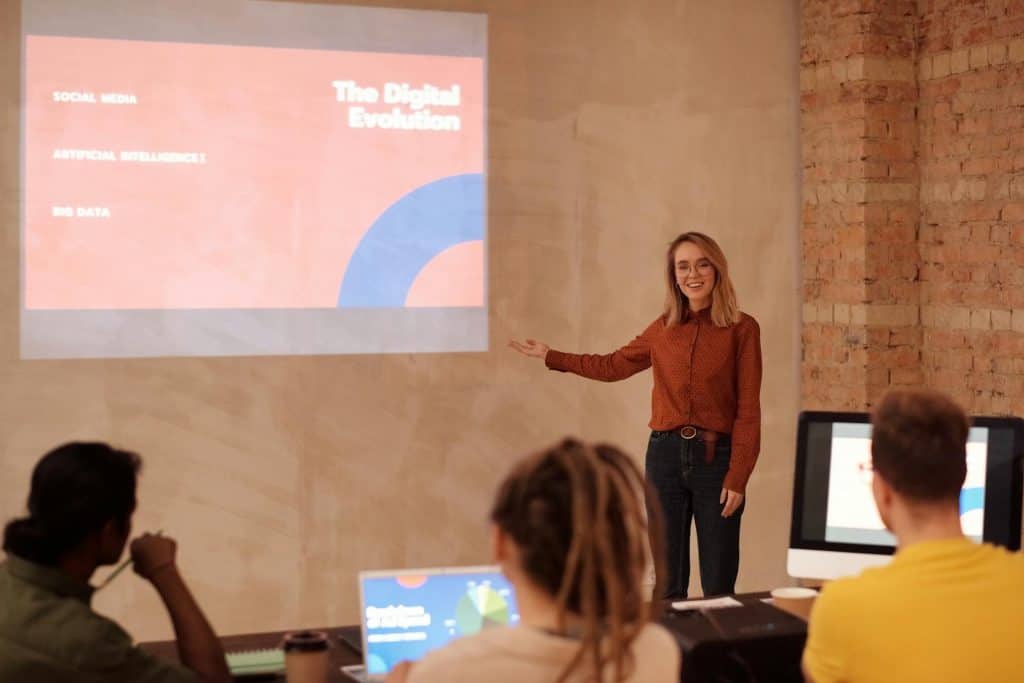Hybrid Mentoring for Junior Staff Success: Boost Career Growth
Mentoring is vital for junior staff. It helps them grow and succeed.
Hybrid mentoring combines both in-person and virtual guidance. This approach offers flexibility and personalized support for new employees. Hybrid mentoring blends traditional face-to-face meetings with digital communication. It suits our modern, fast-paced work environments. Junior staff can benefit from the best of both worlds.
They get the direct interaction of in-person meetings and the convenience of online support. This method ensures constant learning and development. With hybrid mentoring, junior staff can access their mentors anytime, anywhere. It fosters a strong connection and boosts their confidence and skills. Junior staff feel more supported, leading to higher job satisfaction and success. In this blog post, we will explore the key elements and benefits of hybrid mentoring.
Introduction To Hybrid Mentoring
Picture this: You’re a junior staff member stepping into your first big role. Exciting, right? But there’s also that feeling of “What if I mess up?” This is where hybrid mentoring comes in. It’s like having a guiding light, helping you navigate the tricky waters of your new job. Hybrid mentoring combines the best of both worlds—traditional face-to-face mentoring and modern virtual mentoring. Let’s dive into what it is and why it’s important for junior staff success.
What Is Hybrid Mentoring?
Hybrid mentoring is a blend of in-person and online mentoring. It’s like having a mentor in your pocket, anytime and anywhere. You get the personal touch of face-to-face meetings, combined with the flexibility of virtual interactions. Imagine having a quick video call to discuss an urgent issue, or meeting up for coffee to brainstorm ideas. Hybrid mentoring is adaptable and can fit into any busy schedule.
Here’s a quick comparison table to help you understand better:
| Traditional Mentoring | Hybrid Mentoring |
|---|---|
| Face-to-face only | Face-to-face + Online |
| Scheduled meetings | Flexible timing |
| Local mentors | Global mentors |
Importance For Junior Staff
Why is hybrid mentoring so important for junior staff? Well, starting a new job can be overwhelming. You have to learn the ropes, understand the company culture, and perform well—all at once! Hybrid mentoring provides the support you need to succeed. Here are some key benefits:
- Access to Expertise: You can learn from experienced mentors, regardless of their location. This means you get a wider range of knowledge and insights.
- Flexibility: Hybrid mentoring fits into your schedule. You can have quick chats or long discussions, depending on your needs.
- Personal Growth: Regular feedback helps you improve. You can set goals and track your progress with your mentor’s help.
- Networking: You get to connect with professionals in your field. This can open doors to new opportunities.
So, if you’re a junior staff member feeling a bit lost, hybrid mentoring might just be your secret weapon. It’s like having a map and a compass, guiding you to success!
Benefits Of Hybrid Mentoring
Hybrid mentoring is transforming how junior staff grow and succeed in their careers. By blending virtual and in-person interactions, hybrid mentoring offers unique advantages that cater to the diverse needs of junior employees. Let’s explore some key benefits of hybrid mentoring.
Personalized Guidance
One of the standout benefits of hybrid mentoring is the personalized guidance it offers. In a hybrid setup, mentors can tailor their advice and feedback to the specific needs of each mentee. This approach ensures that junior staff receive support that is relevant to their goals and challenges. For instance, a mentor can provide detailed feedback on a project via video call and follow up with in-person brainstorming sessions to refine ideas. This personalized touch helps mentees feel valued and understood, fostering a deeper connection and trust.
Flexibility And Accessibility
Flexibility and accessibility are crucial in today’s fast-paced work environment. Hybrid mentoring addresses these needs by allowing mentees and mentors to connect from anywhere. Junior staff can schedule virtual meetings that fit their busy lives, reducing the stress of coordinating in-person sessions. Moreover, hybrid mentoring makes it easier for mentees to access a diverse pool of mentors, including those who might be geographically distant. This increased access to expertise can significantly enhance the learning experience.
| Benefit | Description |
|---|---|
| Personalized Guidance | Tailored advice based on individual needs. |
| Flexibility | Scheduling virtual meetings anytime, anywhere. |
| Accessibility | Connecting with mentors worldwide. |
- Customized feedback and support
- Convenient meeting times
- Wide access to expert mentors
Hybrid mentoring combines the best of both worlds, offering junior staff the guidance they need to thrive in their roles. Whether it’s through personalized advice or flexible meeting options, the benefits of hybrid mentoring are clear and impactful. So, are you ready to embrace this new mentoring approach and unlock your team’s potential?
Types Of Mentoring Models
Mentoring junior staff is crucial for their success. Different mentoring models can be used to guide them effectively. Here are some common types of mentoring models.
In-person Mentoring
In-person mentoring involves face-to-face interactions. This model allows mentors and mentees to build strong relationships. It also helps in understanding non-verbal cues. This type of mentoring can foster deeper connections. Meetings can be scheduled regularly. These sessions can take place in various settings. Offices, cafes, or even parks can be used.
Virtual Mentoring
Virtual mentoring is done online. It can be conducted through video calls, emails, or chat platforms. This model offers flexibility. Mentors and mentees can connect from different locations. Virtual mentoring can save time and resources. It is ideal for busy schedules. Many platforms provide tools for virtual mentoring. These tools include screen sharing and document collaboration.
Blended Approach
The blended approach combines in-person and virtual mentoring. This model offers the best of both worlds. It provides flexibility and personal connection. Meetings can alternate between online and face-to-face. This approach ensures continuous support. It can cater to different preferences and needs. The blended approach can enhance the mentoring experience.

Credit: www.linkedin.com
Choosing The Right Mentor
Choosing the right mentor can make a world of difference in the success of junior staff. A good mentor not only provides guidance but also helps build confidence and skills. In a hybrid mentoring program, where both in-person and virtual interactions take place, finding the right mentor can be even more crucial. Let’s delve into how you can identify the perfect mentor for your junior staff.
Identifying Skills And Needs
First and foremost, it’s important to understand the specific needs and skills of your junior staff. Are they looking to improve their technical skills? Or do they need guidance on career development and soft skills? Here are some steps to help identify these needs:
- Conduct a Skills Assessment: A simple skills assessment can help determine the strengths and weaknesses of your junior staff.
- Set Clear Goals: Encourage your junior staff to set clear, achievable goals. This will help in identifying the type of mentorship they require.
- Regular Check-Ins: Regular check-ins with your staff can help keep track of their progress and evolving needs.
Once you have a clear understanding of their needs, it becomes easier to find a mentor who can address these specific areas.
Finding The Perfect Match
Finding the perfect mentor is like finding a needle in a haystack. But fear not! With a systematic approach, it can be simplified. Here are some tips to help you find the right match:
- Leverage Your Network: Tap into your professional network to find potential mentors. Recommendations from trusted colleagues can be invaluable.
- Consider Compatibility: Ensure that the mentor’s communication style and personality are compatible with the mentee. A good rapport can significantly enhance the mentoring experience.
- Check Availability: The mentor should have the time and willingness to commit to regular mentoring sessions, whether in-person or virtual.
- Diverse Perspectives: Sometimes, a mentor from a different background or field can provide unique insights and broaden the mentee’s horizons.
Remember, a good mentor is not just a teacher but also a cheerleader and a confidant. They should be someone who genuinely cares about the growth and success of their mentee.
Choosing the right mentor is a critical step in the hybrid mentoring process. By identifying the needs of your junior staff and carefully selecting a mentor who meets these needs, you can set the stage for successful and productive mentorship.
Implementing A Hybrid Mentoring Program
Have you ever wondered how to help new employees succeed? Well, implementing a hybrid mentoring program might be your best bet. This approach combines the best of both worlds – face-to-face interaction and online communication. It ensures that junior staff get the guidance they need, whether they’re in the office or working remotely. Let’s dive into how you can make this work seamlessly.
Setting Clear Goals
First things first, setting clear goals is crucial. Why? Because without direction, neither mentors nor mentees will know what to achieve. Start by identifying what you want from the mentoring program. Do you want to improve job skills, boost confidence, or enhance teamwork?
- Define Objectives: What are the specific skills or knowledge areas you want to focus on?
- Measure Progress: How will you track improvements and success?
- Set Timelines: When do you expect to see results?
Remember, clear goals pave the way for a productive mentoring relationship. They help both parties stay focused and motivated.
Establishing Communication Channels
Now, let’s talk communication. In a hybrid mentoring program, it’s essential to establish effective communication channels. This ensures that mentors and mentees can easily connect, share feedback, and address concerns.
Consider using a mix of the following:
- Email: Great for sharing detailed information and follow-ups.
- Video Calls: Perfect for face-to-face interaction, even when miles apart.
- Chat Apps: Quick and easy for instant messages and casual check-ins.
Additionally, setting regular meetings – weekly or bi-weekly – can help maintain a steady flow of communication. And don’t forget to be flexible. Life happens, and sometimes schedules need to adjust. By keeping communication lines open and adaptable, you foster a supportive and responsive mentoring environment.
With these steps in place, your hybrid mentoring program will be set up for success. Junior staff will feel more supported, motivated, and ready to take on new challenges. And who knows? You might even learn a thing or two along the way.

Credit: www.youtube.com
Overcoming Challenges
Hybrid mentoring combines in-person and online guidance for junior staff. This method is effective but comes with its own set of challenges. How can we make sure these hurdles don’t trip us up? Let’s dive into some common issues and how to tackle them.
Time Management
Time management is a big deal in hybrid mentoring. Coordinating schedules between mentors and mentees is tricky. Here are some tips to make it easier:
- Set Clear Expectations: Agree on meeting times and stick to them.
- Use Calendars: Sync calendars to keep everyone on the same page.
- Prioritize Tasks: Focus on the most important tasks first. Don’t let the little things distract you.
Remember the saying, “Time is money?” Well, in mentoring, time is growth. Junior staff need regular check-ins to stay motivated and on track.
Technology Barriers
Technology can be a double-edged sword. While it connects us, it can also create barriers. Let’s look at some common tech issues and solutions:
- Poor Internet Connection: Ensure both mentor and mentee have a stable connection. Consider backup options like phone calls.
- Software Issues: Stick to reliable platforms. Test software before meetings to avoid disruptions.
- Lack of Tech Skills: Offer training sessions. Make sure everyone is comfortable using the necessary tools.
Once, during a mentoring session, my internet cut out. I had to quickly switch to my phone. It wasn’t ideal, but it showed the importance of being adaptable.
In conclusion, hybrid mentoring has its challenges, but with a bit of planning, we can overcome them. Time management and technology barriers are just bumps in the road. With the right strategies, junior staff can thrive.
Measuring Success
When it comes to hybrid mentoring for junior staff, measuring success is crucial. How do you know if your mentoring program is hitting the mark? By tracking progress, gathering feedback, and tweaking your approach, you can ensure your junior staff are thriving. Let’s dive into the nuts and bolts of measuring success.
Tracking Progress
First things first, you need to keep an eye on how your mentees are doing. Are they improving? Are their skills getting better? Tracking progress helps you answer these questions. Here are some ways to do it:
- Regular Check-ins: Schedule regular meetings with your mentees. These can be weekly or bi-weekly. Use these sessions to discuss their progress and any challenges they face.
- Setting Goals: At the start of the mentoring relationship, set clear goals. These could be learning new skills, completing projects, or improving performance. Track how well these goals are being met.
- Performance Reviews: Use performance reviews to gauge progress. These reviews can highlight areas of improvement and areas where the mentee excels.
Gathering Feedback
Feedback is a goldmine of information. It tells you what’s working and what isn’t. Here are some ways to gather feedback effectively:
- Surveys: Conduct surveys to get feedback from your mentees. Ask them what they find useful and what they struggle with.
- One-on-One Meetings: Have honest conversations with your mentees. Ask open-ended questions to get detailed feedback.
- Peer Feedback: Encourage mentees to get feedback from their peers. Sometimes, colleagues can offer insights that mentors may miss.
Remember, feedback isn’t just about finding faults. It’s about improving and growing together. For example, I once had a mentee who was struggling with time management. Through feedback, we discovered that breaking tasks into smaller chunks helped. It was a game-changer!
Measuring success in hybrid mentoring isn’t rocket science, but it does require effort and attention. Track progress, gather feedback, and adapt. Your junior staff will thank you for it!

Credit: disasteravoidanceexperts.com
Real-life Success Stories
Real-life success stories provide valuable insights into the impact of hybrid mentoring. They show how junior staff can thrive with the right guidance. Here, we share two case studies that highlight significant achievements.
Case Study 1
Meet Sarah, a junior software developer at a mid-sized tech firm. She struggled with coding challenges in her first few months. Her mentor, a senior developer, offered weekly hybrid sessions. These included both virtual and in-person meetings. They discussed projects, solved coding issues, and set goals. Sarah’s skills improved rapidly. Within six months, she led a small project team. Her confidence and performance soared. The hybrid mentoring approach was key to her growth.
Case Study 2
John, a new marketing assistant, faced difficulties in creating effective campaigns. His mentor, a marketing manager, used a hybrid mentoring model. They had bi-weekly online check-ins and monthly face-to-face meetings. The mentor provided practical tips, reviewed John’s work, and offered constructive feedback. John learned to craft compelling campaigns. He soon managed social media accounts independently. This success boosted his career prospects. The blend of online and offline mentoring proved effective.
Future Of Hybrid Mentoring
The future of hybrid mentoring holds great potential for junior staff success. It combines the best of both in-person and virtual mentoring. This approach helps create a supportive and flexible learning environment. Junior staff benefit from face-to-face interactions and the convenience of online communication. As technology evolves, hybrid mentoring will continue to grow and adapt.
Trends And Innovations
New trends are shaping the future of hybrid mentoring. Virtual reality (VR) tools offer immersive learning experiences. AI-powered platforms personalize mentoring programs for each junior staff member. These innovations make mentoring more engaging and effective. They help mentors track progress and provide timely feedback. The use of data analytics helps identify areas for improvement. These trends ensure that mentoring stays relevant and impactful.
Long-term Impact
Hybrid mentoring has a lasting impact on junior staff. It helps build strong professional relationships and networks. This approach fosters a culture of continuous learning and growth. Junior staff develop essential skills and gain confidence. They learn to adapt to changing work environments. The long-term benefits include increased job satisfaction and career advancement. Hybrid mentoring prepares junior staff for future challenges and opportunities.
Frequently Asked Questions
How Do You Mentor Junior Staff?
I mentor junior staff by providing regular feedback, setting clear goals, and encouraging open communication. I offer guidance through training sessions and one-on-one meetings. I foster a supportive environment for learning and growth.
What Are The 5 Pillars Of Mentorship?
The 5 pillars of mentorship are: guidance, support, wisdom, encouragement, and accountability. These elements help mentees grow and succeed.
What Are The 5 Stages Of Mentoring?
The 5 stages of mentoring are: 1. Rapport Building, 2. Goal Setting, 3. Skill Development, 4. Feedback and Reflection, 5. Closure.
How Mentoring Affects Career Success?
Mentoring boosts career success by providing guidance, networking opportunities, and skill development. It helps in setting clear career goals.
Conclusion
Hybrid mentoring boosts junior staff success. Combining online and in-person guidance offers balance. Junior staff gains valuable skills quickly. Mentors provide real-time feedback and support. This approach fosters growth and confidence. Organizations benefit from skilled, motivated employees. Embrace hybrid mentoring for effective staff development.
It’s practical, flexible, and impactful. Junior staff thrives with personalized learning. Hybrid mentoring is a smart investment.


